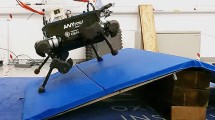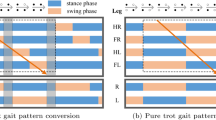Abstract
This paper studies quadrupedal bounding in the presence of flexible torso and compliant legs with non-trivial inertia, and it proposes a method for speed transitions by sequentially composing locally stable bounding motions corresponding to different speeds. First, periodic bounding motions are generated simply by positioning the legs during flight via suitable (virtual) holonomic constraints imposed on the leg angles; at this stage, no control effort is developed on the support legs, producing efficient, nearly passive, bounding gaits. The resulting motions are then stabilized by a hybrid control law which coordinates the movement of the torso and legs in continuous time, and updates the leg touchdown angles in an event-based fashion. Finally, through sums-of-squares programming, formally verified estimates of the domain of attraction of stable fixed points are employed to realize stable speed transitions by switching among different bounding gaits in a sequential fashion.







Similar content being viewed by others
Explore related subjects
Discover the latest articles, news and stories from top researchers in related subjects.Notes
Given the relatively high stiffness value of the leg spring, this assumption represents a reasonable approximation of the liftoff condition, which occurs when the vertical component of the ground reaction force becomes zero and the vertical acceleration of the toe is directed upwards.
Note that \(\mathcal{D}_0\) and \(\mathcal{D}_1\) do not represent the domains of attraction of the entire periodic orbits \({ \phi }_0\) and \({ \phi }_1\).
References
Cao Q, Poulakakis I (2012) Passive quadrupedal bounding with a segmented flexible torso. In: Proceedings of the IEEE/RSJ International Conference on Intelligent Robots and Systems, pp 2484–2489
Cao Q, Poulakakis I (2013) Quadrupedal bounding with a segmented flexible torso: passive stability and feedback control. Bioinspiration Biomimetics 8(4):046007
Cao Q, Poulakakis I (2015) On the energetics of quadrupedal running: predicting the metabolic cost of transport via a flexible-torso model. Bioinspiration Biomimetics 10(5):056008
Cao Q, van Rijn AT, Poulakakis I (2015) On the control of gait transitions in quadrupedal running. In: Proceedings of the IEEE/RSJ International Conference on Intelligent Robots and Systems, pp 5136–5141
Culha U, Saranli U (2011) Quadrupedal bounding with an actuated spinal joint. In: Proceedings of the IEEE International Conference on Robotics and Automation, pp 1392–1397
Deng Q, Wang S, Xu W, Mo J, Liang Q (2012) Quasi passive bounding of a quadruped model with articulated spine. Mech Mach Theory 52:232–242
Full R, Koditschek DE (1999) Templates and anchors: Neuromechanical hypotheses of legged locomotion on land. J Exp Biol 202:3325–3332
Khalil HK (2002) Nonlinear Systems, 3rd edn. Prentice Hall, Upper Saddle River
Motahar MS, Veer S, Poulakakis I (2016) Composing limit cycles for motion planning of 3D bipedal walkers. In: IEEE Conference on Decision and Control. To appear
Papadopoulos D, Buehler M (2000) Stable Running in a Quadruped Robot with Compliant Legs. In: Proceedings of the IEEE International Conference on Robotics and Automation, pp 444–449
Park HW, Kim S (2015) Quadrupedal galloping control for a wide range of speed via vertical impulse scaling. Bioinspiration Biomimetics 10(2):025003
Parrilo PA (2000) Structured semidefinite programs and semialgebraic geometry methods in robustness and optimization. Ph.D. thesis, California Institute of Technology
Poulakakis I, Papadopoulos EG, Buehler M (2006) On the stability of the passive dynamics of quadrupedal running with a bounding gait. Int J Robot Res 25(7):669–687
Pouya S, Khodabakhsh M, Spröwitz A, Ijspeert A (2016) Spinal joint compliance and actuation in a simulated bounding quadruped robot. Autonomous Robots pp 1–16
Prajna S, Papachristodoulou A, Seiler P, Parrilo PA (2004) New developments in sum of squares optimization and SOSTOOLS. In: Proceedings of the American Control Conference, pp 5606–5611
Raibert MH (1986) Legged Robots that Balance. MIT Press, Cambridge
Schmiedeler JP, Siston R, Waldron KJ (2002) The significance of leg mass in modeling quadrupedal running gaits. In: Bianchi G, Guinot JC, Rzymkowski C (eds) ROMANSY 14: Theory and Practice of Robots and Manipulators. Springer, Vienna, pp 481–488
Seipel JE (2011) Analytic-holistic two-segment model of quadruped back-bending in the sagittal plane. In: Proceedings of ASME Mechanisms and Robotics Conference, vol 6, pp 855–861
Seyfarth A, Geyer H, Herr H (2003) Swing leg retraction: a simple control model for stable running. J Exp Biol 206:2547–2555
Tedrake R, Manchester IR, Tobenkin M, Roberts JW (2010) LQR-trees: feedback motion planning via sums-of-squares verification. Int J Robot Res 29(8):1038–1052
Wang X, Li M, Wang P, Sun L (2011) Running and turning control of a quadruped robot with compliant legs in bounding gait. In: Proceedings of the IEEE International Conference on Robotics and Automation, pp 511–518
Westervelt ER, Grizzle JW, Chevallereau C, Choi JH, Morris B (2007) Feedback control of dynamic bipedal robot locomotion. Taylor & Francis/CRC Press
Yamasaki R, Ambe Y, Aoi S, Matsuno F (2013) Quadrupedal bounding with spring-damper body joint. In: Proceedings of IEEE/RSJ International Conference on Intelligent Robots and Systems, pp 2345–2350
Zhang ZG, Fukuoka Y, Kimura H (2005) Stable quadrupedal running based on a spring-loaded two-segment legged models. In: Proceedings of the IEEE International Conference on Robotics and Automation, vol 3, pp 2601–2606
Author information
Authors and Affiliations
Corresponding author
Additional information
This work is supported in part by NSF CAREER Award IIS-135072 and ARL contract W911NF-12-1-0117.
This work was presented in part at the 1st International Symposium on Swarm Behavior and Bio-Inspired Robotics, Kyoto, Japan, October 28–30, 2015.
About this article
Cite this article
Cao, Q., Poulakakis, I. Quadrupedal running with a flexible torso: control and speed transitions with sums-of-squares verification. Artif Life Robotics 21, 384–392 (2016). https://doi.org/10.1007/s10015-016-0330-5
Received:
Accepted:
Published:
Issue Date:
DOI: https://doi.org/10.1007/s10015-016-0330-5




